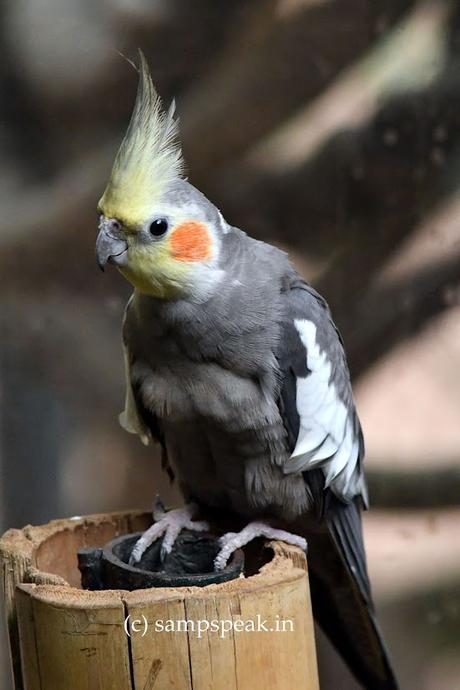Nymphicus hollandicus may not hit the brain ! – but likely you have seen this elsewhere ! - and do you know where ‘New Holland’ is !!
சொல்ல வல்லாயோ?-கிளியே! சொல்ல நீ வல்லாயோ?-
தில்லை யம்பலத்தே -நடனம் செய்யும் அமரர்பிரான்-அவன்
செல்வத் திருமகனை- இங்கு வந்து சேர்ந்து கலந்து மகிழ்ந்திடு வாயென்று (சொல்ல)
சொல்ல வல்லாயோ கிளியே அற்புதமான வரிகளை கொண்ட மஹாகவி பாரதியார் பாடல்

விந்தன் என்று அறியப்பட்ட கோவிந்தன் புதின எழுத்தாளர். மாசிலாமணி முதலியார் நடத்திய "தமிழரசு" மாத இதழில் அச்சுக் கோப்பவராக வேலை பார்த்து, பிறகு ஆனந்த விகடன் அச்சுக் கூடத்தில் பின்னர் கல்கி கிருஷ்ணமூர்த்தியால் 1941ஆம் ஆண்டு தொடங்கப்பட்ட கல்கி இதழ், என வேலைகள் செய்து வந்த இவர் சில நாவல்கள் எழுதினர். 1954ம் ஆண்டு எம். ஜி. ஆர், சிவாஜி கணேசன், பி. எஸ். சரோஜா, டி. டி. குசலகுமாரி நடித்த கூண்டுக்கிளி விந்தன் எழுத, டி. ஆர். ராமண்ணா இயக்கத்தில் வெளிவந்தது. நண்பனுடைய மனைவி மேல் ஆசை கொள்ளும் ஜீவா எனும் எதிர்மறைப் பாத்திரத்தில் சிவாஜி. சிவாஜி எம்ஜியார் இருவரும் நடித்தும் இது பெரிய தோல்விப்படம். படத்தில் டி.வி.ரத்தினம் , கதாநாயகி BS சரோஜாவிற்காகப் பாடியது சொல்ல வல்லாயோ கிளியே எனும் பாரதியார் பாடல், சிவாஜியின் கனவுப்பாடலாக!!
பல ஆண்டுகள் பின்னர் 1979ல் எஸ்.பி.முத்துராமன் இயக்கத்தில் சிவாஜி , கல்கத்தா விஸ்வநாதன், பிரமீளா, எஸ்.வரலக்ஷ்மி, ஸ்ரீதேவி, நடித்த கவரிமான் இளையராஜாவின் இன்னிசையில் பாரதியார் பாட்டு எஸ்.வரலக்ஷ்மி பாடும் சொல்ல வல்லாயோ. ( பாரதியார்- கிளி விடு தூது) அவர் கச்சேரி செய்வதுபோல் காட்சியமைப்பு.
காக்டீல்ஸ், என்றும் அழைக்கப்படுகிறது நிம்ஃபிகஸ் ஹாலண்டிகஸ், கிளிகளின் ஒரு பிரியமான இனமாகும். ஆஸ்திரேலியாவை பூர்வீகமாகக் கொண்ட இந்த குட்டி கிளிகள் அவற்றின் தனித்துவமான முகடுகள், வட்ட ஆரஞ்சு கன்னத் திட்டுகள் மற்றும் நீண்ட, நேர்த்தியான வால் இறகுகளுக்காக அங்கீகரிக்கப்பட்டுள்ளன. உலகெங்கிலும் உள்ள பல குடும்பங்களுக்கு, அவர்கள் ஒரு நேசத்துக்குரிய செல்லப் பிராணியாக இந்த கிளிகள் உள்ளன.
New Holland is a historical European name for mainland Australia. The name was first applied to Australia in 1644 by the Dutch seafarer Abel Tasman. The name came for a time to be applied in most European maps to the vaunted "Southern land" or Terra Australis even after its coastline was finally explored. The continent of Antarctica, later named in the 1890s, was still in largely speculative form; it resumed the name Terra Australis (sometimes suffixed Non Cognita, unknown). Its existence had been speculated on in some maps since the 5th century, under the theory of "balancing hemispheres".
Lieutenant James Cook, captain of HMS Endeavour, claimed the eastern portion of the Australian continent for the British Crown in 1770, naming it New South Wales. The British settlement of Sydney as a colony in 1788 prompted Britain to formally claim the east coast as New South Wales, leading to a search for a new collective name. New Holland was never settled by the Dutch people, whose colonial forces and buoyant population had a settled preference for the Dutch Cape Colony, Dutch Guyana, the Dutch East Indies, Dutch Ceylon and the Dutch West Indies.

The cockatiel (Nymphicus hollandicus), also known as the weero/weiro [ is a medium-sized parrot that is a member of its own branch of the cockatoo family endemic to Australia. They are prized as household pets and companion parrots throughout the world and are relatively easy to breed compared to other parrots. As a caged bird, cockatiels are second in popularity only to the budgerigar.
Originally described by Scottish writer and naturalist Robert Kerr in 1793 as Psittacus hollandicus, the cockatiel (or cockateel) was moved to its own genus, Nymphicus, by Wagler in 1832. Its genus name reflects the experience of one of the earliest groups of Europeans to see the birds in their native habitat; the travellers thought the birds were so beautiful that they named them after mythical nymphs. The specific name hollandicus refers to New Holland, a historical name for Australia.
Interesting !
With regards – S Sampathkumar
24.5.2024

